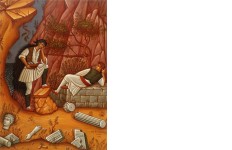TITΛΟΣ ΕΡΓΟΥΕΛΛΗΝΕΣ ΠΟΛΕΜΙΣΤΕΣ ΣΤΟΝ ΠΟΛΕΜΟ ΤΗΣ ΑΝΕΞΑΡΤΗΣΙΑΣ
ΔΙΑΣΤΑΣΕΙΣ ΕΡΓΟΥΎψος : 100
Πλάτος : 73
ΥΛΙΚΟ ΚΑΤΑΣΚΕΥΗΣΕλαιογραφία (Λάδι σε καμβά)
ΥΠΟΓΡΑΦΗ ΚΑΛΛΙΤΕΧΝΗΚάτω Δεξιά
ΧΡΟΝΟΛΟΓΗΣΗ01-01-1948
ΕΛΕΓΧΟΣ ΓΝΗΣΙΟΤΗΤΑΣΔεν έχει ελεγχθεί

Provenance:
Acquired from the artist by the present owner in 1948.
Exhibited:
Athens, National Gallery and Alexander Soutzos Museum, Fotis Kondoglou, 1978, no. 21, p. 36 (illustrated in the catalogue)
A prolific artist and writer, Kontoglou is the true advocate for the revival of the Byzantine pictorial tradition in Greece. Although much of his work consists of secular subject matter, his style remained true to the Byzantine aesthetic of a limited space, landscapes with rugged mountains, stylised figures and earthy hues. Occasionally the faces of his figures betray influences from the portraits of Fayuum.
Kontoglous ambition was to create a genuine Greek art for the 20th century. Although well versed in western art, he believed that the roots of the new artistic vision he sought could be found not in a European aesthetic, but in Byzantine and folk art, whose spontaneity and lack of sophistication, he felt, came straight from the artists heart.
Works by Kontoglou rarely come to auction. The present work, from 1948, is a rare exception epitomizing Kontoglous quest for an authentic Greek art. It is directly related to one of the scenes from the spectacular series of wall frescoes that he did for the interior of the Athens Municipal Building in 1937-1940. The theme of these remarkable works, which constitute the artists major achievement, revolves around the continuity of Greeces ancient heritage. (cf. Nikos Zias, Fotis Kontoglou, Athens, 1991, no. 269 (illustrated). The painting shows two casually posed heroes of the Greek War of Independence in 1821, depicted next to fragments from an ancient temple that are strewn on the ground. One of the men is an armatolos and the other is a klepht. The former was a member of an armed band of Greeks authorised by the Ottoman Turks to protect a region assigned to him while the latter was a rebel Greek who lived in the mountains. Both fought against the Turks.
The golden hues of the ground continue in the cliff that rises along the left edge of the painting. Balancing the composition are the mountain slopes that loom on the right side. The rugged forms of the mountains are drawn directly from Byzantine art. The two figures, dressed in the traditional foustanella kit of the 19th century, evoke life in the countryside, which affords a distant view of the -typically Greek- blue sea and sky.
Kontoglou described these brave fighters as being built like lions, with the blood of the ancients coursing through their veins, living in the open as God made them, with beards, moustaches, long hair like Christ, fleet-footed, eating meagerly, devout, humble before their elders and priests, with a soul full of secret riches. (quoted in Nikos Zias, Fotis Kontoglou, Athens, 1991, p. 99).